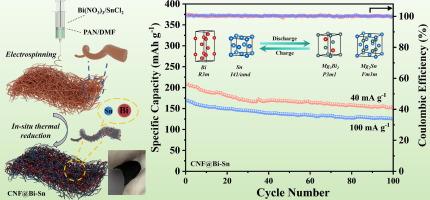Bimetallic Bi–Sn nanoparticles in-situ anchored in carbon nanofiber as flexible self-supporting anode toward advanced magnesium ion batteries
IF 13.3
1区 工程技术
Q1 ENGINEERING, CHEMICAL
引用次数: 0
Abstract
With the unprecedented rise of flexible electronic technology, it is imperative to develop the matched flexible power supply systems. Magnesium ion battery (MIB), as a promising next-generation battery system, shows significant potential as a power source for flexible electronic devices. However, the research on flexible MIB remains in its infancy, and the exploration of novel and reliable flexible electrodes is crucial. Herein, a binder-free and flexible self-supporting electrode with bimetallic Bi–Sn nanoparticles anchored in carbon nanofiber (CNF@Bi-Sn) was fabricated via electrospinning method combined with subsequent calcinations, and applied to MIBs for the first time. The CNF@Bi-Sn simultaneously integrated the advantages of hierarchical porous carbon nanofiber framework, the homodisperse nanosized Bi-Sn particles, and the increased phase/grain boundaries, which were beneficial for improving the structural stability and facilitating Mg2+ diffusion kinetics. The CNF@Bi-Sn alloy anode demonstrated impressive performance with high initial specific capacity of 738mAh/g, exceptional rate capability and outstanding cycling stability of 150mAh/g at 40 mA g−1 after 100 cycles. Significantly, the quantitative kinetic analysis, ex-situ SEM, TEM and XRD were conducted to reveal the structural evolution during cycling and the magnesium storage mechanism based on reversible two-phase alloying/de-alloying transformation reactions. Furthermore, the full batteries were assembled, demonstrating its potential for practical applications. This protocol sheds light on exploring high-performance flexible self-supporting alloy anode for future flexible power systems.

双金属铋锡纳米颗粒原位锚定在纳米碳纤维中作为先进镁离子电池的柔性自支撑阳极
随着柔性电子技术的空前发展,开发与之配套的柔性电源系统势在必行。镁离子电池(MIB)作为一种极具发展前景的下一代电池系统,在柔性电子设备的电源领域显示出巨大的潜力。然而,柔性电极的研究仍处于起步阶段,探索新颖可靠的柔性电极至关重要。本文采用静电纺丝结合后续煅烧的方法,制备了一种无粘结剂、柔性的双金属Bi-Sn纳米粒子锚定在纳米碳纤维(CNF@Bi-Sn)上的自支撑电极,并首次应用于纳米材料。CNF@Bi-Sn同时结合了分层多孔碳纳米纤维骨架、均匀分散的纳米Bi-Sn颗粒和增大的相/晶界等优点,有利于提高结构稳定性和促进Mg2+扩散动力学。CNF@Bi-Sn合金阳极表现出令人印象深刻的性能,具有738mAh/g的高初始比容量,卓越的倍率能力和出色的循环稳定性,在40 mA g−1循环100次后可达到150mAh/g。通过定量动力学分析、非原位SEM、TEM和XRD分析,揭示了循环过程中的结构演变以及基于可逆的两相合金化/脱合金化转变反应的镁储存机理。此外,还组装了完整的电池,展示了其实际应用的潜力。该协议为探索未来柔性电力系统的高性能柔性自支撑合金阳极提供了思路。
本文章由计算机程序翻译,如有差异,请以英文原文为准。
求助全文
约1分钟内获得全文
求助全文
来源期刊

Chemical Engineering Journal
工程技术-工程:化工
CiteScore
21.70
自引率
9.30%
发文量
6781
审稿时长
2.4 months
期刊介绍:
The Chemical Engineering Journal is an international research journal that invites contributions of original and novel fundamental research. It aims to provide an international platform for presenting original fundamental research, interpretative reviews, and discussions on new developments in chemical engineering. The journal welcomes papers that describe novel theory and its practical application, as well as those that demonstrate the transfer of techniques from other disciplines. It also welcomes reports on carefully conducted experimental work that is soundly interpreted. The main focus of the journal is on original and rigorous research results that have broad significance. The Catalysis section within the Chemical Engineering Journal focuses specifically on Experimental and Theoretical studies in the fields of heterogeneous catalysis, molecular catalysis, and biocatalysis. These studies have industrial impact on various sectors such as chemicals, energy, materials, foods, healthcare, and environmental protection.
文献相关原料
公司名称
产品信息
阿拉丁
N,N-dimethylformamide (DMF)
阿拉丁
Aluminum chloride (AlCl3)
阿拉丁
Lithium chloride (LiCl)
阿拉丁
Phenyl magnesium chloride (C6H5MgCl)
 求助内容:
求助内容: 应助结果提醒方式:
应助结果提醒方式:


